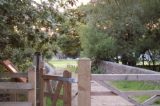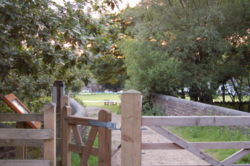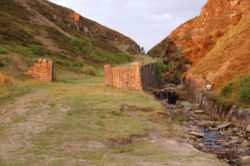
White Coppice
Encyclopedia
White Coppice is a hamlet near Chorley
, Lancashire
, England. It was the most populated part of the township of Anglezarke
in the 19th century. Close to the settlement in the early 19th century were quarries and small coal mines. The hamlet lies to the north of Anglezarke Reservoir
in the Rivington
reservoir
chain built to provide water for Liverpool
in the mid 19th century. To the south west is a hill known as Healey Nab
.
White Coppice had a cotton mill
at the start of the Industrial Revolution
. Its mill lodge provided water for a steam engine and before that the mill was powered by a waterwheel on the Black Brook
. Around 1900 the mill was owned by Alfred Ephraim Eccles a supporter of the Temperance movement
.


is played at a ground in the hamlet. The 1st and 2nd XI cricket teams play in the Moore and Smalley Palace Shield.
Chorley
Chorley is a market town in Lancashire, in North West England. It is the largest settlement in the Borough of Chorley. The town's wealth came principally from the cotton industry...
, Lancashire
Lancashire
Lancashire is a non-metropolitan county of historic origin in the North West of England. It takes its name from the city of Lancaster, and is sometimes known as the County of Lancaster. Although Lancaster is still considered to be the county town, Lancashire County Council is based in Preston...
, England. It was the most populated part of the township of Anglezarke
Anglezarke
Anglezarke is a sparsely populated civil parish in the Borough of Chorley in Lancashire, England. It is dominated by reservoirs that were built to supply water to Liverpool, and a large expanse of moorland with evidence of Bronze Age settlements...
in the 19th century. Close to the settlement in the early 19th century were quarries and small coal mines. The hamlet lies to the north of Anglezarke Reservoir
Anglezarke Reservoir
Anglezarke Reservoir is the largest reservoir in the Rivington chain to the west of Anglezarke in Lancashire, England. Anglezarke Reservoir has three embankments, the longest, the Charnock Embankment is 777 metres long and 9.45 metres high, the Knowsley Embankment is 219.5 metres long and 14...
in the Rivington
Rivington
Rivington is a small village and civil parish of the Borough of Chorley, Lancashire, England, occupying . It is about southeast of Chorley and about northwest of Bolton. Rivington is situated on the fringe of the West Pennine Moors, at the foot of Rivington Pike...
reservoir
Reservoir
A reservoir , artificial lake or dam is used to store water.Reservoirs may be created in river valleys by the construction of a dam or may be built by excavation in the ground or by conventional construction techniques such as brickwork or cast concrete.The term reservoir may also be used to...
chain built to provide water for Liverpool
Liverpool
Liverpool is a city and metropolitan borough of Merseyside, England, along the eastern side of the Mersey Estuary. It was founded as a borough in 1207 and was granted city status in 1880...
in the mid 19th century. To the south west is a hill known as Healey Nab
Healey Nab
Healey Nab or "The Nab" is an area of countryside owned by Lancashire County Council containing rolling hills, moorland, woodland, ponds and streams to the east of Chorley, Lancashire between the M61 and the West Pennine Moors. To the south east is Anglezarke Reservoir and to the north east White...
.
White Coppice had a cotton mill
Cotton mill
A cotton mill is a factory that houses spinning and weaving machinery. Typically built between 1775 and 1930, mills spun cotton which was an important product during the Industrial Revolution....
at the start of the Industrial Revolution
Industrial Revolution
The Industrial Revolution was a period from the 18th to the 19th century where major changes in agriculture, manufacturing, mining, transportation, and technology had a profound effect on the social, economic and cultural conditions of the times...
. Its mill lodge provided water for a steam engine and before that the mill was powered by a waterwheel on the Black Brook
Black Brook (Chorley)
Black Brook in Lancashire has its source at Great Hill in the West Pennine Moors. The water is acidic due to a high level of peat in the uplands near to Round Loaf, giving the brook its black colour. The young river was known as Warth Brook in olden Heapey. A feeder stream also known as Black...
. Around 1900 the mill was owned by Alfred Ephraim Eccles a supporter of the Temperance movement
Temperance movement
A temperance movement is a social movement urging reduced use of alcoholic beverages. Temperance movements may criticize excessive alcohol use, promote complete abstinence , or pressure the government to enact anti-alcohol legislation or complete prohibition of alcohol.-Temperance movement by...
.
Notable residents
- Walter HaworthWalter HaworthSir Norman Haworth was a British chemist best known for his groundbreaking work on ascorbic acid while working at the University of Birmingham. He received the 1937 Nobel Prize in Chemistry "for his investigations on carbohydrates and vitamin C"...
was born here on 19 March 1883 and won a Nobel PrizeNobel PrizeThe Nobel Prizes are annual international awards bestowed by Scandinavian committees in recognition of cultural and scientific advances. The will of the Swedish chemist Alfred Nobel, the inventor of dynamite, established the prizes in 1895...
in chemistry.


Cricket
CricketCricket
Cricket is a bat-and-ball game played between two teams of 11 players on an oval-shaped field, at the centre of which is a rectangular 22-yard long pitch. One team bats, trying to score as many runs as possible while the other team bowls and fields, trying to dismiss the batsmen and thus limit the...
is played at a ground in the hamlet. The 1st and 2nd XI cricket teams play in the Moore and Smalley Palace Shield.

